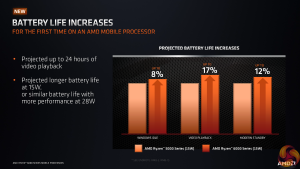It is clear that AMD has focussed on power optimisation and performance per Watt for Zen 3+. The changes from Zen 3 to Zen 3+ are not significant in terms of cores or cache. But they are instead focussed on making more power efficient use of the resources at hand… as well as upgrading to TSMC’s 6nm manufacturing process.
The first critical introduction for Ryzen 6000 Mobile is the improvement to a Zen 3+ based core design. According to AMD, ‘the Plus is all about efficiency’, indicating that optimisations for power draw and battery life will be key to the adjustments.
Five layers for this power optimisation approach are highlighted; Process Technology, Microarchitecture, SoC, Firmware, Platform.
For Process Technology, AMD has opted for TSMC’s 6nm manufacturing process instead of the 7nm node that we have seen previously. But TSMC N6 is more of an evolution to N7 – with higher density and some EUV usage sprinkled in – than a wholehearted design change like N5. As such, the key power optimisations perhaps come from the other four pillars.
Microarchitecture revolves around the new ‘Zen 3+’ core design. Some of the key power optimisation benefits here include incredibly fine control of the CPU cores. Each core can be turned off individually to allow the processor to operate at its most sensible – workload-dependent – power state. And CPPC has been improved to per-thread capability, not just per-core like previous.
Another area where AMD has focussed for a power optimised microarchitecture is in the cache department. Several changes made to the cache systems including better adjustments to deal with cache misses and higher-level pools.
The SoC also undergoes the processor-wide power optimisation treatment. Additional power states have been added in. And AMD has partitioned the display controllers into a different power domain to give more granular control over what is and is not active. There are also new power states added to the Infinity Fabric.
Called Power Management Framework (PMF), this firmware-level tool is AMD’s take on a laptop’s operating continuum between typical ‘Silent’ and ‘Performance’ power/performance profiles. This allows the laptop to ingest data from an array of sensors and optimise the position on its performance curve, without simply being glued to often more rigid manufacturer-designed profiles.
There’s still the option to run standard ‘Silent’ power profiles and the likes; this is simply AMD’s take on an automated – balanced – operating mode.
Notable for the platform segment of the power optimisations is a focus on display consumption. There’s support for new <1W panels, panel self-refresh can be used to optimise graphics horsepower allocation, and there’s the usual sprinkling of AMD Advantage Technologies to optimise power between the processor and graphics.
With all of the power consumption enhancements bundled together, AMD is highlighting that battery life for up to 24 hours of video playback is possible with Ryzen 6000U. To be clear, this will depend on several factors, including the display and battery chosen by a laptop vendor.
But it is a clear indication of the confidence that AMD has in its Zen 3+ power efficiency enhancements’ ability to offer strong battery life when deployed correctly.
KitGuru says: There are plenty of exciting new features to test out on Ryzen 6000 Series Mobile processors. The underlying Zen 3+ core architecture has clearly been designed to enhance power efficiency inside mobile machines. But with DDR5 support, PCIe Gen 4, and brand new RDNA2-based graphics cores, we are certainly excited to get our first look at laptops with the new chips inside. Stay tuned.
 KitGuru KitGuru.net – Tech News | Hardware News | Hardware Reviews | IOS | Mobile | Gaming | Graphics Cards
KitGuru KitGuru.net – Tech News | Hardware News | Hardware Reviews | IOS | Mobile | Gaming | Graphics Cards












